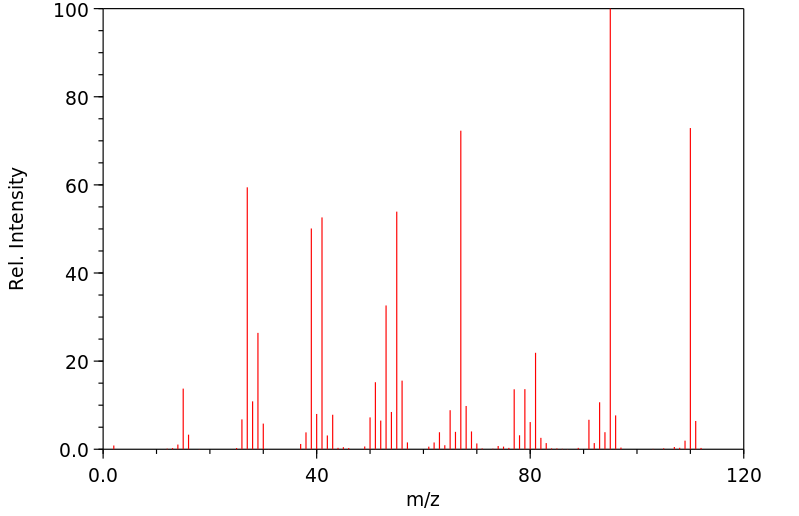(2E,4Z)-3,4-二甲基己-2,4-二烯 | 2417-88-1
中文名称
(2E,4Z)-3,4-二甲基己-2,4-二烯
中文别名
——
英文名称
(E,Z)-3,4-dimethyl-2,4-hexadiene
英文别名
(E,Z)-3,4-dimethylhexa-2,4-diene;E,Z-3,4-dimethyl-2,4-hexadiene;E,Z-tetramethylbutadiene;(2E,4Z)-3,4-dimethyl-hexa-2,4-diene;3,4-dimethyl-hexa-2c,4t-diene;3,4-Dimethyl-hexa-2c,4t-dien;2,4-Hexadiene, 3,4-dimethyl-, (E,Z)-;(2E,4Z)-3,4-dimethylhexa-2,4-diene
CAS
2417-88-1
化学式
C8H14
mdl
——
分子量
110.199
InChiKey
PBGBMQLUDCDJQJ-CGXWXWIYSA-N
BEILSTEIN
——
EINECS
——
-
物化性质
-
计算性质
-
ADMET
-
安全信息
-
SDS
-
制备方法与用途
-
上下游信息
-
文献信息
-
表征谱图
-
同类化合物
-
相关功能分类
-
相关结构分类
物化性质
-
沸点:113-115 °C
-
密度:0.747±0.06 g/cm3(Predicted)
计算性质
-
辛醇/水分配系数(LogP):3.6
-
重原子数:8
-
可旋转键数:1
-
环数:0.0
-
sp3杂化的碳原子比例:0.5
-
拓扑面积:0
-
氢给体数:0
-
氢受体数:0
安全信息
-
海关编码:2901299090
SDS
上下游信息
反应信息
-
作为反应物:描述:(2E,4Z)-3,4-二甲基己-2,4-二烯 在 盐酸 、 sodium hydroxide 、 sodium periodate 、 四氧化锇 作用下, 以 溶剂黄146 、 甲苯 为溶剂, 反应 12.5h, 生成参考文献:名称:一种非对映选择性合成不饱和无环胺的方法摘要:二烯和N-亚磺酰基甲苯磺酰胺的Diels-Alder加合物可用于合成具有可预测的立体化学和双键几何结构的均烯丙基胺衍生物。DOI:10.1016/s0040-4039(00)81583-x
-
作为产物:描述:参考文献:名称:Thermochemistry of the orthogonal butadienes (Z,Z)-3,4-dimethylhexa-2,4-diene and 2,3-di-tert-butylbuta-1,3-diene摘要:DOI:10.1021/ja00214a036
文献信息
-
Thermal decomposition of vinylic copper(I) and silver(I) organometallic compounds作者:George M. Whitesides、Charles P. Casey、Jeanne K. KriegerDOI:10.1021/ja00735a011日期:1971.3s'7-rr During these studies several-qroups have prepared and characterizecl authentic aromatic and vinylic organonretallic compounds of these me[als.'-r'r The thernial stability of this class of compounds , although low conrpared with the stabilities ol nrain group organometallic cotltpounds, appeared tu Lrs to be sullicient to make a derailed investigation ot' the ir thernral decom position a practical顺式和反式-L-丙烯基铜(I)和顺式的热分解。trctns-l-丙烯基(三正丁基膦)铜(t)生成铜(O)和 2.4-己二烯,在烯属双键上有构型。这种立体化学结果,当根据已知的乙烯基基团构型反转速率来解释时,不足以证明游离丙烯基不是这些热耦合反应的中间体。对类似的 2-丁烯基-铜 (t) 和银 ([) 化合物分解时观察到的立体化学保留情况进行比较,其中立体化学完全丧失;在用三正丁基氢化锡还原顺式和 rruns-2-bromo-2-丁烯时观察到的 UNDCR 自由基条件定性地支持了类似的结论。trun.t-propt-'nyllithium 转化为 2.4-己二烯的产率和化学反应与多种过渡金属盐的转化率的研究表明,在这些偶联中,丙烯基的比例不会发生变化。芳基镁和锂基团的反应被广泛地用作制备 birvls.r- 的反应;大多数情况下认为该反应可将过渡金属芳基转化为中间产物;分离产物这些热不稳定中
-
Conrotatory Photochemical Ring Opening of Alkylcyclobutenes in Solution. A Test of the Hot Ground-State Mechanism作者:Bruce H. O. Cook、William J. Leigh、Robin WalshDOI:10.1021/ja003860o日期:2001.6.1and cis- and trans-tricyclo[6.4.0.0(2,7)]dodec-1(2)-ene (cis- and trans-9)-were selected so as to span a broad range in molecular weight and as broad a range as possible in Arrhenius parameters for thermal (ground-state) ring opening. RRKM calculations have been carried out to provide estimates of the rate constants for ground-state ring opening of each of the compounds over a range of thermal energies已使用 228 nm 激发在己烷溶液中测量了六种烷基环丁烯的光化学开环的量子产率,该激发选择性地填充这些分子的最低 pi,R(3s) 激发单线态,并且先前已显示导致开环清洁旋转立体化学。本工作中研究的化合物 - 1,2-二甲基环丁烯 (1)、顺式和反式 1,2,3,4-四甲基环丁烯(顺式和反式 5)、六甲基环丁烯 (8) 以及顺式和反式选择三环[6.4.0.0(2,7)]dodec-1(2)-ene (cis-和trans-9)-以跨越宽范围的分子量和尽可能宽的Arrhenius参数范围用于热(基态)开环。已进行 RRKM 计算以提供每种化合物在 20 000 至 49 000 cm(-1) 热能范围内的基态开环速率常数的估计值。这些已被用于通过热基态机制估计开环量子产率的上限,假设 k(deact) = 10(11) s(-1) 的值用于碰撞失活的速率常数溶剂,从最低里德堡态到基态的内部
-
Cyclobutene Photochemistry. Steric Effects on the Photochemical Ring Opening of Alkylcyclobutenes作者:William J. Leigh、J. Alberto PostigoDOI:10.1021/ja00111a004日期:1995.2total quantum yield for ring opening increases to a maximum of -0.3 and then decreases with further methyl substitution. The quantum yields for ring opening (t q5tod for the cis-isomer is significantly lower, but both yield an approximate 1:l mixture of formally allowed and forbidden diene isomers. A similar trend is observed in the relative quantum yields for ring opening and cycloreversion throughout碳氢化合物溶液中光化学开环和环回复的量子产率已确定为六种 1,2-二甲基环丁烯衍生物的直接光解 (214 nm),这些衍生物在 C3 和 C4 处含有甲基,数量从 0 到 4。随着母体化合物(1,2-二甲基环丁烯)的 C& 上的氢被甲基数量的增加所取代,开环的总量子产率增加到最大值 -0.3,然后随着进一步的甲基取代而降低。开环的量子产率(顺式异构体的 t q5tod 显着较低,但两者都产生了形式上允许和禁止的二烯异构体的大约 1:1 混合物。在开环和环回复的相对量子产率中观察到类似的趋势在整个系列中。结果被解释为结合强度和空间效应对开环过程效率的影响。由于 C3-C4 键的逐渐减弱,增加甲基取代会导致通过系列的前三个成员增加@total。与仅基于键强度效应所预期的相比,含有顺式二甲基取代的化合物的开环量子产率显着降低。这被认为是由于对过程效率的空间效应,表明环丁烯光化学开环的初始阶段涉及激发单线态势能表面上的旋向运动。由于
-
Stereospecific (Conrotatory) Photochemical Ring Opening of Alkylcyclobutenes in the Gas Phase and in Solution. Ring Opening from the Rydberg Excited State or by Hot Ground State Reaction?作者:William J. Leigh、Bruce H. O. CookDOI:10.1021/jo990618v日期:1999.7.1phase (1 atm; SF6 buffer) and in hydrocarbon solvents with 193-, 214-, and 228-nm light sources. The major products are the isomeric dienes from electrocyclic ring opening and 2-butyne + alkene (ethylene or E-/Z- 2-butene) due to formal [2+2]-cycloreversion. The total yields of dienes relative to 2-butyne are generally higher in the gas phase than in solution but decrease with increasing excitation1,2-二甲基环丁烯和顺式和反式 1,2,3,4-四甲基环丁烯的光化学已在气相(1 atm;SF6 缓冲液)和烃溶剂中进行了研究,其中 193-、214- 和 228 -nm 光源。主要产物是由电环开环产生的异构二烯和由于形式[2+2]-环转化产生的2-丁炔+烯烃(乙烯或E-/Z-2-丁烯)。二烯相对于 2-丁炔的总产率在气相中通常高于在溶液中,但在两组条件下随着激发波长的增加而降低。对于顺式-1,2,3,4-四甲基环丁烯,228-nm 光解导致立体定向形成 E,Z-3,4-二甲基-2,4-己二烯[分子式:见正文]对应的异构体通过热允许(旋转)电循环途径开环[公式:见正文]在气相和溶液中。所有三种二烯异构体都是在反式-1,2,3,4-四甲基环丁烯的 228 nm 光解后获得的,但对照实验表明热允许的异构体(E,E- 和 Z,Z-3,4-二甲基-2 ,3-己二烯) 也可能是这种情况下的主要产品。结果与由低位
-
Weinreb, Steven M.; Garigipati, Ravi S.; Gainor, James A., Heterocycles, 1984, vol. 21, # 1, p. 309 - 324作者:Weinreb, Steven M.、Garigipati, Ravi S.、Gainor, James A.DOI:——日期:——
表征谱图
-
氢谱1HNMR
-
质谱MS
-
碳谱13CNMR
-
红外IR
-
拉曼Raman
-
峰位数据
-
峰位匹配
-
表征信息
同类化合物
高密聚乙烯
香叶醇
顺式3-甲基-2-己烯
顺式-5-癸烯
顺式-5-甲基-2-己烯
顺式-5-庚烯-1-炔
顺式-4-癸烷
顺式-4-甲基-2-戊烯
顺式-4-甲基-2-戊烯
顺式-3-癸烯
顺式-3-甲基-3-己烯
顺式-3-甲基-2-庚烯
顺式-3-戊烯-1-炔
顺式-3,4-二甲基-3-己烯
顺式-3,4-二甲基-2-戊烯
顺式-3,4-二甲基-2-戊烯
顺式-2-甲基-3-己烯
顺式-2-壬烯
顺式-2-丁烯-D1
顺式-1.1.1-三甲基-2-丁烯
顺式-1-甲基-2-环丙基乙烯
顺式-1-甲基-2-乙烯基环戊烷
顺式-1-环戊基-1-辛烯
顺式-1-氘代-3-甲基-1-丁烯
顺式-(9ci)-2,3,3a,7a-四氢-4-(1-甲基乙基)-1H-茚
顺式-(2-丁烯基)环丙烷
顺式,顺式-2,4-己二烯
顺-环辛烯
顺-9-二十一碳烯
顺-6-十三碳烯
顺-5-甲基-1,3,6-庚三烯
顺-4-辛烯
顺-4-壬烯
顺-3-辛烯
顺-3-甲基-2-戊烯
顺-3-壬烯
顺-3-十三碳烯
顺-2-辛烯
顺-2-癸烯
顺-2-戊烯
顺-2-庚烯
顺-2-己烯
顺-2-丁烯
顺-2,2-二甲基-3-己烯
顺-1,3-戊二烯
顺,顺-1,9-环十六烷二烯
顺,顺,顺-环癸-1,3,5-三烯
间戊二烯
间二(4-吡啶基)苯
镁,二-2-丁烯基-







